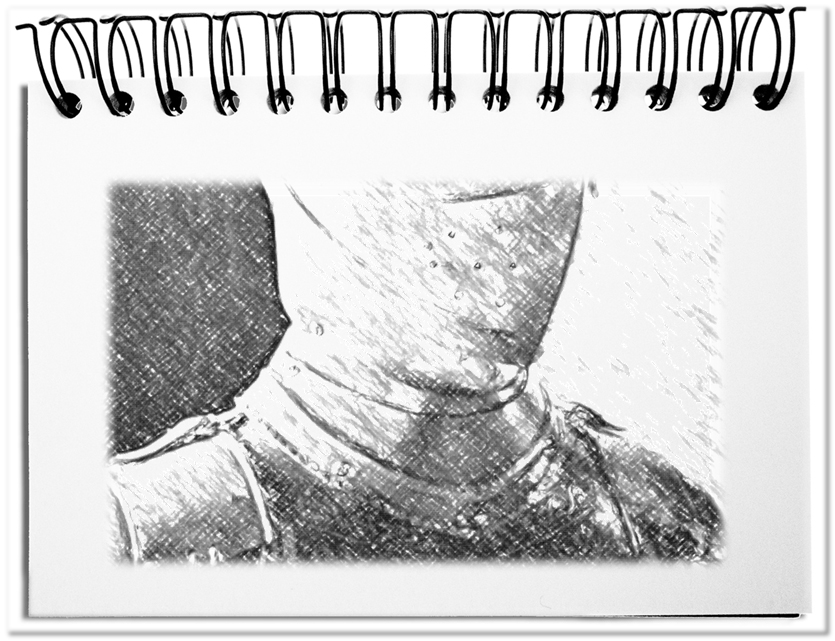Unternehmen, die lange existieren und über die Zeit gewachsen sind, haben viele Herausforderungen bewältigt – veränderte Anforderungen des Marktes, neue Technologien, verschiedene Zusammenarbeitsstile. Mit der Zeit haben sich diese Firmen einen maßgefertigten Panzer an Aufbau- und Ablaufstrukturen, Regeln und Vorgaben entwickelt, der möglichst jede Eventualität abdecken sollte. So wie die Rüstung eines Ritters ein zusätzliches Gewicht von 30 kg bedeutete, tragen auch die Unternehmen einen riesigen Ballast an Richtlinien mit sich herum. Auch wenn dieser Harnisch an die Proportionen seines Nutzers angepasst ist, beschränkt er die Beweglichkeit und erzeugt damit eine gewisse Fragilität. Wie löst man sich von dem „Fr“?
Eine Rüstung besteht aus verschiedenen Metallplatten, die für bestimmte Teile des Körpers einer einzelnen Person geschmiedet wurden – der Helm, das Bruststück, das Armzeug, die Schenkeldecke, das Kniestück, die Beinröhre und vieles mehr. Auch das Unternehmen entwickelt intern Regelungen für seine verschiedenen Bereiche. Um agil zu werden, ist es entscheidend, die folgenden Aspekte zu berücksichtigen.
- Vision
Das Bild eines idealen, zukünftig agilen Zustands des Unternehmens bildet die Grundlage für den Verzicht auf die über Jahre entwickelten, detaillierten Festlegungen. Die Vision baut auf der idealen Vorstellung der Mitarbeiter, der weiteren Ressourcen und dem kundenorientierten Zusammenwirken auf. Die Elemente, die diese Vision behindern, müssen aufgelöst werden. - Überzeugungen
Alle Beteiligten haben mit der Zeit Denkweisen aufgebaut, die bei der Agilisierung stören. Die Mitarbeiter müssen sich davon lösen, dass sie von außen motiviert, angeleitet und beauftragt werden müssen. Die Führungskräfte müssen sich davon lösen, dass sie die Mitarbeiter direkt steuern, kontrollieren und sanktionieren. Das magische Wort der Zukunft ist Selbstorganisation. - Intrinsische Motivation
Um das Momentum in einem Unternehmen zu erhalten, wurden entsprechende extrinsische Belohnungen und Anreize entwickelt – die Bezahlung, der Bonus, die Karriere, die Weiterbildung. In der Selbstorganisation werden andere Anreize wichtig, die den Mitarbeiter von innen antreiben – die Befriedigung eine Tätigkeit durchzuführen, eine Kompetenz zu haben, seine Neugierde befriedigen zu können oder durch die Tätigkeit einen persönlichen Selbstzweck erreichen zu können. - Vertrauen
Den größten Vertrauensvorschub müssen die Eigentümer leisten. Sie kommen nicht umhin den direkten Einfluss aufzugeben und zu glauben, dass die interne Gesellschaft, die Mitarbeiter, das wirtschaftliche Geschick so lenken, dass das Unternehmen überlebensfähig und wirtschaftlich einträglich bleibt. Die Zuversicht, dass die intrinsische Motivation das erforderliche Zusammenwirken der Mitarbeiter sicherstellt und dadurch ergiebige Resultate spontan entstehen, ist die Grundvoraussetzung dafür, dass die Mitarbeiter überhaupt die Chance bekommen, sich zu beweisen. - Organisatorische Offenheit
Das bestehende Kettenhemd zu öffnen, sodass die Möglichkeit zur selbstorganisierten Vernetzung und Teambildung überhaupt entsteht, erfordert viel Mut. Die DNA eines Unternehmens hat sich derart in das Bewusstsein der Mitarbeiter gebrannt, dass es eine große Anstrengung erfordert, sich von dem lieb gewordenen Gefühl der Sicherheit zu lösen. Ein Unternehmen und zwei Ansätze erfordern neutrale Zonen, in denen sich die Mitarbeiter ausprobieren können, ohne den alten, etablierten Wegen folgen zu müssen. - Governance
Die Einführung eines grundsätzlichen Regelwerks, dass kurz und leicht verständlich die neuen Prinzipien, die Wege der Abstimmung, die gemeinsame Sicht und klare Aufgaben, Kompetenz und Verantwortung beschreibt, ist eine wichtige Vorbedingung. Denkbar ist es Sonderbereiche einzuführen, so wie es China mit seinen Sonderwirtschaftszonen (z.B. Shenzhen, Hainan, Hongkong) gemacht hat. In diesem Bereich können völlig neue Ansätze getestet werden – Holacracy, PODS, Plattformen. - Plattform
Selbstorganisierte Einheiten sind fokussiert auf ihr Thema. Sich wiederholende Tätigkeiten und allgemein benötigte Dienstleistungen stören dabei. Aus diesem Grund ist es geschickt, die Teams von bestimmten grundsätzlichen Aufgaben zu befreien. Die Bündelung dieser Umfänge in einer Plattform steigert die Wirksamkeit der Einheiten. In der Plattform finden sich standardisierte Vorgehen und Werkzeuge als Dienstleistung – IT, Infrastruktur, Logistik, usw.
Im Zuge der (Fr)agilität bestehen die Mitarbeiter nicht nur aus den ausführenden Personen, sondern auch aus den steuernden, dem sogenannten Management. Der anstehende Verlust an Macht, der sich aus der Selbstorganisation ergibt, ist die größte Herausforderung, da Führung sich zukünftig aus dem Zusammenhang und nicht mehr durch die klassische Karriere ergibt. Es führt die Person, die am meisten Menschen begeistert und mitreißt und nicht mehr der am besten angepasste Karrierist.
Fazit: Die (Fr)agilität von Unternehmen wird bestimmt durch die Rüstung, die die Bewegungsfreiheit beeinträchtigt. Dazu gehören die Aufbau- und Ablaufstruktur, das etablierte Regelwerk, dass versucht alles bis auf den letzten Handgriff zu regeln. Um die Transformation hin zum agilen Unternehmen zu schaffen, braucht es in jeder Einheit eine Vision, gemeinsame Überzeugungen, intrinsische Motivation, Vertrauen, organisatorische Offenheit, Governance und eine allgemeine Plattform, die den agilen Einheiten zur Verfügung steht. Bedroht wird die Agilität durch die, die am meisten zu verlieren haben – die Führungskräfte. Aus diesem Grund brauchen sie Perspektiven, die auch ihnen das Überleben ermöglicht.

